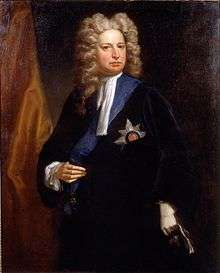1710 British general election
The 1710 British general election produced a landslide victory for the Tories in the wake of the prosecution of Henry Sacheverell and the collapse of the previous Whig government led by Godolphin and the Whig Junto. In November 1709 the clergyman Henry Sacheverell had delivered a sermon fiercely criticising the government's policy of toleration for Protestant dissenters and attacking the personal conduct of the ministers. The government had Sacheverell impeached, and he was narrowly found guilty but received only a light sentence, making the government appear weak and vindictive; the trial enraged a large section of the population, and riots in London led to attacks on dissenting places of worship and cries of "Church in Danger".
| ||||||||||||||||||||||
All 558 seats in the House of Commons 280 seats needed for a majority | ||||||||||||||||||||||
|---|---|---|---|---|---|---|---|---|---|---|---|---|---|---|---|---|---|---|---|---|---|---|
| ||||||||||||||||||||||
The government's unpopularity was further increased by its enthusiasm for the war with France, as peace talks with the French king Louis XIV had broken down over the government's insistence that the Bourbons hand over the Spanish throne to the Habsburgs. The Tories' policy of pursuing peace appealed to a country worn out by constant war. Queen Anne, disliking the Junto and sensing that the government could not survive long, gradually replaced it with a Tory ministry throughout the summer of 1710. The overwhelming Tory victory surprised few, and following the election most remaining Whigs resigned from office. The new government was led by the moderate Tory Robert Harley who was unpopular among the more partisan Tories, and his ministry faced increasing pressure from the extremists whose position in Parliament had been enormously strengthened by the result. Contests occurred in 131 constituencies in England and Wales, around half the total; the election was bitterly contested in almost all the counties and "open" boroughs, even when a poll was not held.
Summary of the constituencies
See 1796 British general election for details. The constituencies used were the same throughout the existence of the Parliament of Great Britain.
Dates of election
The general election was held between 2 October 1710 and 16 November 1710. At this period elections did not take place at the same time in every constituency. The returning officer in each county or parliamentary borough fixed the precise date (see hustings for details of the conduct of the elections).
See also
- 3rd Parliament of Great Britain
- List of MPs elected in the British general election, 1710
- List of Parliaments of Great Britain
References
- British Electoral Facts 1832–1999, compiled and edited by Colin Rallings and Michael Thrasher (Ashgate Publishing Ltd 2000). (For dates of elections before 1832, see the footnote to Table 5.02).

